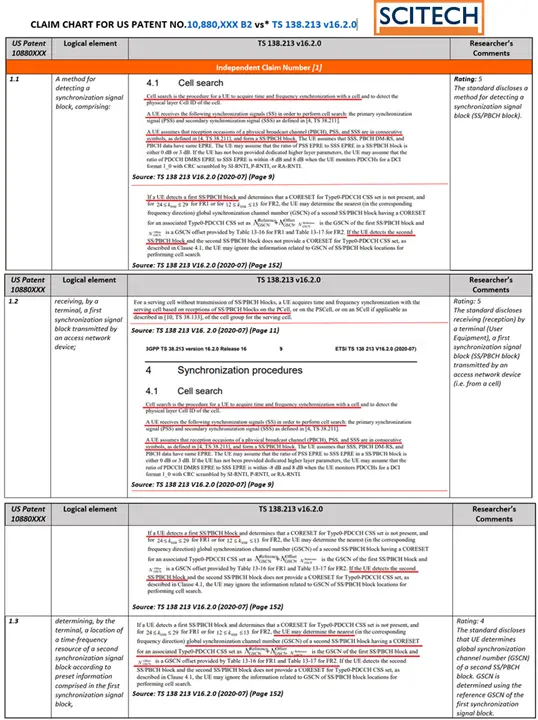It is the intention of both “Standards” and “Patents” to encourage innovation, where a “Standard” offers access to technology to drive compatibility and interoperability between devices manufactured by different companies, while a “Patent” offers exclusive rights to an inventor as a reward for their work and investment while fostering technological innovation. And a “Standard Essential Patent” (SEP) ” is a patent that claims an invention that conforms to a given set of technical standards. Many companies who are committed to developing innovative technologies are actively contributing towards advancement of technical standards, thereby building up their portfolio of patents and SEPs. Such Standard Essential Patents (SEP) generate billions of dollars for their owners, create opportunities for cooperation in the market and benefit consumers.
What are standards and why are standards essential?
Standards or technical standards are published literature containing technical specifications that provide uniformity in product development by establishing consistent protocols or guidelines industry-wide that can be globally accepted.
Standards are produced by consortiums such as Standard Development Organizations (SDOs) or Standard Setting Organizations (SSOs) with contributions from industry / trade organizations, technical experts, government / private organizations and consumers of the technology.
There are two types of standards:
de facto standards
A standard established when a specific technology is widely embraced by the general public, becoming the dominant technology in the market even though it has not been officially adopted by a Standard Setting Authority. Examples include the QWERTY keyboard, the Windows operating system, etc.
de jure standards
The standards framed formally by Standard Setting Organizations (SSOs) such as the ISO (International Organization for Standardization), International Telecommunication Union (ITU), European Telecommunications Standards Institute (ETSI), etc. The duty of SSOs is to coordinate and facilitate a standard-setting process with the involvement of varied stakeholders.
With the rapid pace of globalization, manufacturers, businesses, consumers, governments have gained numerous benefits from adopting technical standards such as:
- Standards drive interoperability and compatibility among various devices
- Standards improve overall product quality with a focus on increased safety and reliability
- Standards fosters competition and innovation of new products / technologies
- Standards speed up time-to-market and
- Standards enable local or international trade for businesses
- Standards offer economies of scale
A few examples of standards that have been widely accepted include:
- Cellular / mobile communications technologies such as 3G, 4G, 5G, have been made easily available to travelers to use these services across the globe.
- Wireless networking technologies such as IEEE 802.11, Wi-Fi, Bluetooth have changed the method of accessing the Internet.
- Device connectivity technologies such as USB 1.0, USD 2.0, and USB 3.0 offer “plug-and-play” convenience by allowing external devices to be connected to personal computers.
What are Standard Essential Patents (SEPs)?
As part of the process of defining standards, standard-setting organizations include technologies that are essential to the proposed standard, as well as patented technologies. As a result, several patents claim inventions that comply with a given set of standards. These patents are known as “Standard Essential Patents” since they are essential to specific standards.
In order for these “standard essential patents” to be disclosed, their owners must submit declarations to Standard Setting Organizations such as the ETSI, 3GPP, ISO and others. By doing so, implementers or manufacturers may leverage the standard-compliant technologies to make, use and sell their products. They may also use technologies covered by “standard essential patents” for which they will need to obtain a license from one of the SEP holders. Therefore, licensing principles such as “fair, reasonable and non-discriminatory (FRAND) exist for owners of the standard essential patents”. Owners of “Standard Essential patents” license their standard-compliant technologies based on FRAND licensing principles with the objective that owners gain economic returns while providing affordable access to implementers.
What is FRAND?
While SEP owners have exclusive rights to practice their technologies for a specific time-period, the aim of Standard Setting Organizations is to widely promote implementation of technologies defined as standards. Therefore, usage of SEPs is governed by policies defined by Standard Setting Organizations, wherein SEP owners make a voluntary licensing commitment with the SSO to license their relevant patents to implementers of the standards on Fair, Reasonable and Nondiscriminatory (FRAND) terms. These policies comprise:
Fair licensing terms that are not anti-competitive and not unlawful, and allow competition to thrive.
Reasonable royalty rates charged by the SEP owner to adequately reward themselves for investing and contributing towards patents that are essential for standards and protect implementers (licensees) from excessive royalties.
Non-discriminatory terms that require that SEP owners should not discriminate in the licensing of SEPs and treat each individual licensee in a similar manner.
What challenges exist in regard to Standard Essential Patents?
Declaration of SEPs
The declaration process of standard essential patents is currently not consistent, as some standard essential patents may not clearly refer to a standard document, or may refer to a standard without specifying the standard version, or may just refer to the main project or may not necessarily be a standard-essential; and in some cases, may not be even reported.
Essentiality assessment of SEPs
Owners of SEPs submit a disclosure to SSOs in the form of self-declarations, which is typically based on the good faith and personal knowledge of the company representative making the declaration. Though SSOs typically have policies that provide guidelines on how patents or patent claims are to be classified as “essential” to a standard, the interpretation of the essentiality requirement is subjective and requires verification of accuracy.
Licensing agreements
Licensing of SEPs is a major challenge posed to both implementers and SEP owners, as determining royalty rates are difficult when negotiating SEP licenses.
What are Patent Pools?
Patent pools are formed when multiple patent owners come together with the aim of mutually licensing their patents or licensing them as a package to third parties. Patent pools benefit implementers or licensees by lowering royalty rates or providing advanced technological solutions for a large customer base or avoiding IP infringement.
What are the SEP-related services offered by SPA?
SciTech Patent Art consists of experts in Electronics and Telecommunications with extensive experience in standard-essential patents. We work with companies on search and analyses of both standard specifications and patent claims of SEPs.
Our services include
As several Standard Setting Organizations are involved in defining standards, there is no consolidated source available for all the standards in a specific industry. Further, companies declare standard-essential patents at their own discretion, therefore, there is no verification of the information provided or accuracy of it.
Mapping of patents to specific standards is a tedious and time-consuming process. To identify the matching standards, you need to understand the technology as well as be able to search for them.
- Claim charts are useful for infringement analysis or for identifying potential licensing opportunities. In a claim chart, the product features are mapped to specific technical standards or to the claims of SEPs.
- Claims charts can also be used to check whether SEP conforms to declared standards by mapping independent claims to corresponding technical standards.
- It is useful during licensing negotiations to have a claim chart to indicate the quality of one’s patent portfolio.
Patent owners who declared their patent as SEPs would be interested in knowing their usage across countries. Finding the relevant products that are implementing SEPs enables the patent owners to obtain a monetary benefit via licensing discussions.
Patent owners self-declare their patents that are potentially essential to standard specifications to Standard Setting Organizations. Consequently, patent owners may over-declare patents that are not really essential to standard specifications. Especially when implementers are in licensing negotiations with SEP owners, it is crucial to screen and assess the declared patents to determine whether those are actually essential. In order to evaluate the essentiality of SEPs, it is helpful to involve the objective opinions of a third party who is experienced in evaluating standard specification documents and patent claims.
Why SciTech Patent Art?
SPA has 20+ years of experience providing succinct findings based on technical analyses. Our difference lies in the responsiveness we show our clients, the depth of expertise we demonstrate in our work and the attention we pay to detail. Searches and analyses related to Standards and SEPs are conducted by domain experts with IP knowledge. In addition, SPA analysts are equipped with proprietary tools that assist in their workflow process. For example –
- The automated Claim Chart Generator, BridgeIndex™, divides a claim into multiple elements based on the functionality / component.
- SPA’s proprietary AI/ML tools and Deep Web search techniques are integrated into the overall workflow process to deliver efficiency and effectiveness.
What is the methodology?
Some of the questions or requests from our clients have been as follows:
 We intend to validate a patent’s essentiality against a set of declared standards.
We intend to validate a patent’s essentiality against a set of declared standards.- We have a patent number for which we would like to search and identify related standards.
- We are interested in a particular technology and would like SPA to search for patents & standards.
- Is it possible for SPA to search for products related to a particular technology / patent that we are interested in.
- Could SPA assist us in identifying licensing opportunities by searching for and preparing a list of vendors and operators?
- Are you able to search for licensees associated with a particular technology or SEP as well?
What is the approach adopted by SPA to develop SEP claim charts?
-
- Review patent / application / technology for better understanding.
- Use SPA’s proprietary & automated Claim Chart Generator, BridgeIndex™ to divide a claim into multiple elements based on the functionality / components.
- Identify relevant technical specifications / standards using SPA’s Deep Web Search tool.
- Analyze and map each claim element & patent drawings to technical specification / standard. As per the below-given Example 01.
- Provide rating of claim elements that indicate essentiality score:
Ratings (0-5)
0 = 0% or not essential
1 = 1-25% or very unlikely to be essential
2 = 26-50% or unlikely to be essential
3 = 51-75% or likely to be essential
4 = 76% – 99% or very likely to be essential
5 = 100% or essential - Provide a summary of analysis for claims and technical specification, and comments of the analyst:
- Search in several Standard Setting Organization websites such as

What is the approach adopted by SPA to develop product claim charts?
- Review patent / application / technology for better understanding.
- Use SPA’s proprietary & automated Claim Chart Generator, BridgeIndex™ to divide a claim into multiple elements based on the functionality / components.
- Identify relevant products using SPA’s Deep Web Search tool.
- Analyze and map each claim element & patent drawings to product specification as per the Example 2 & 3 below.
- Provide color coding of claim elements, that indicate relevancy to the product feature.

- Provide a summary of analysis for claims and technical specification and comments of the analyst.



